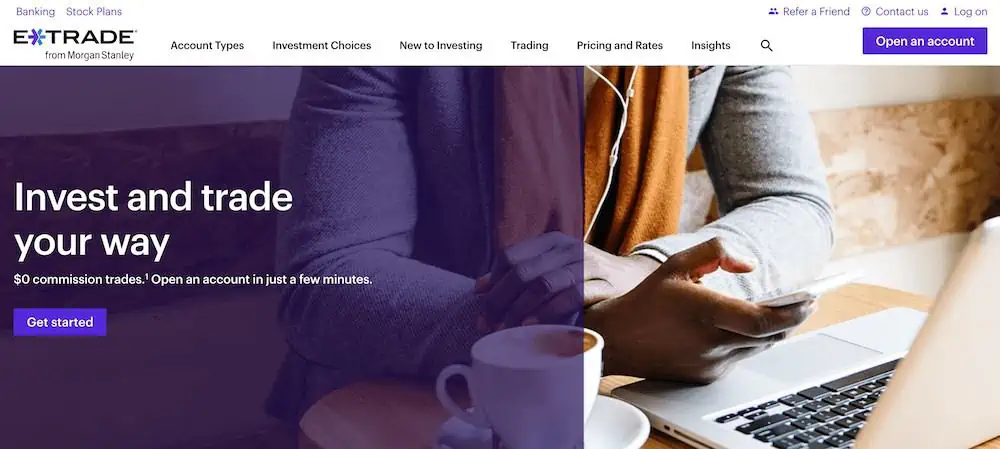Stock trading can seem like a daunting task for newcomers—especially teenagers learning about it for the first time.
But you’ll be glad to know: It doesn’t have to be.
In general, the earlier you start investing, the better. Investing during your teenage years builds valuable habits, maximizes the potential of compound interest, and can even earn you more through tax advantages if done via a retirement account like a Roth IRA.
That said, stock trading for teens isn’t going to be exactly like trading when you’re an adult. Investing money as a kid involves different rules than someone who doesn’t start investing until later in life. So in addition to learning how to invest, it’s important to understand how minors can legally invest, and what types of investing apps allow teens to trade stocks.
Let’s talk about stock trading for teens. We’ll cover a few definitional basics, rules, and the best places to start your journey in investing. After all: The more you know now, the fewer “learning opportunities” (read: mistakes) you’ll make along the way!
Table of Contents
Best Custodial Account—Our Top Pick: E*Trade
What Is the Stock Market?
The stock market is a place where buyers and sellers come together to trade shares in publicly traded companies with one another.
Stock markets essentially act like auctions. Potential buyers name the highest price they’re willing to pay (called “the bid”) and potential sellers name the lowest price they will accept (“the ask”).
When you want to purchase stock in a company, you set your bid price by placing an order on an exchange through a stock broker. This broker finds another person interested in selling at a price you wish to pay, or closely matching your bid to their ask.
Once the market finds two or more parties interested in filling a trade at the agreed-upon price, the brokers deliver the shares and cash proceeds to the respective accounts.
The actual execution of the trade price takes place between the bid and ask prices.
Neither the buyer nor the seller receives the full amount of money paid or received in the transaction because the brokers capture a tiny portion through the spread between the bid and ask prices.
Think of this bid-ask spread as a price of admission. It’s used to pay online discount brokers and the market exchange for facilitating the transaction. While often small with respect to the single transaction, taken across the entirety of the volume of shares traded on a daily basis, it amounts to serious money.
Many free stock trading apps monetize this trading volume through a system called “payment for order flow,” or PFOF. You can learn a little more about that from the links below.
Related:
Can You Trade Stocks If You’re Younger Than 18?
If you wonder whether teens under 18 can trade stocks, the answer is yes, you can invest as a minor … with an asterisk or two.
While you can start investing while you’re a teenager, it can only be done via certain types of investment accounts. Teenagers can actually trade stocks and other investments themselves via:
- a joint brokerage account (you co-own the account with your parent or guardian)
- a regular brokerage account that you have permission to use (your parent or guardian will own the account)
Then there are a couple other types of accounts where an adult invests on behalf of a teenager:
- a custodial account (your parent or guardian invests on your behalf)
- a custodial Roth IRA (your parent or guardian invests on your behalf; when you withdraw in retirement, those withdrawals are tax-free)
For teenagers who have an interest in selecting individual stocks, ETFs, or mutual funds, consider opening a free custodial account from E*Trade or one of the other top investing apps for teens. The best stock apps will be loaded with features, and some will even provide instant sign-up bonuses.
We cover our top free custodial account from E*Trade below.
Related: How Old Do You Have to Be to Buy Stocks?
E*Trade (Top Teen Investing App/Custodial Account)

- Platforms: Web, mobile app (Apple iOS, Android)
- Price: No monthly fees or trading commissions on stocks and ETFs through E*Trade’s Custodial Account
Most people know E*Trade as one of the leading providers of individual brokerage accounts, but you can also put the powerful platform to work saving for your child’s future, through a custodial account (and even a custodial IRA).
E*Trade’s custodial account for teens (and generally any minor) allows you to open up a custodial account that offers the chance to build a personalized portfolio through thousands of stocks, bonds, ETFs, and mutual funds, or you can have E*Trade select your holdings for you through its Core Portfolio robo-advisory service (minimum account size of $500 is needed to use this product). Further, you can choose to open a traditional custodial IRA or a custodial Roth IRA for children under age 18 who have earned income.
Just like with its individual brokerage accounts for adults, E*Trade custodial accounts offer zero-commission stock, ETF, and options trading. It also has a leg up on some platforms by offering $0-commission mutual fund, Treasury, and new-issue bond trading.
And if you want to learn more about investing—or want your young one to learn alongside you—E*Trade also boasts educational resources, including articles, videos, classes, monthly webinars, and even live events.
For a limited time, E*Trade offers a new account funding bonus (when you use reward code “OFFER25”) in the following amounts:
- $1,000-$4,999 earns $50.
- $5,000-$19,999 earns $150.
- $20,000-$49,999 earns $200.
- $50,000-$99,999 earns $300.
- $100,000-$199,999 earns $600.
- $200,000-$499,999 earns $800.
- $500,000-$999,999 earns $1,000.
- $1,000,000-$1,499,999 earns $3,000.
- $1,500,000-$1,999,999 earns $5,000.
- $2,000,000 or more earns $6,000.
To open a free E*Trade custodial account, click “Open Account” below.
Related: 10 Best Debit Cards for Teens [Reviewed by a CPA + Father]
Why Investing Young Is So Important
Some of the wealthiest people in the world built their fortunes by investing in stocks—and starting from an early age. Perhaps most famously, Warren Buffett began investing in his teens and now has over $100 billion in personal wealth.
He started young and developed his wealth building habits from his early years.
Minors should learn how to invest as a teenager because they bring a unique perspective no other investor older than them can. For example, you are a consumer who sees new offerings and what potential they have.
In my case, I saw the growth and rise of online retailers like Amazon and Shopify, social media giants like Facebook and Twitter, major tech companies like Alphabet, Apple and Netflix as well as auto manufacturers like Tesla or even cryptocurrencies like Bitcoin.
Because you have dialed in interests with hyper focus on them, you might know about the next great companies entering the market because you interact with them on a regular basis. Choosing to follow through on your projections by investing in these companies’ stocks might show you the power of conviction and even the satisfaction of aligning your money with your interests.
What Is Stock Trading for Teens?
Stocks act as some of the best investments for teenagers because they tend to provide a long-term focus on growth and higher returns. They carry higher risks traditionally than investments like bonds, but young investors can tolerate this volatility due to their long investment horizons.
Starting to invest as early as possible makes complete sense as the practice relies on building sustainable habits to last a lifetime. This means taking time to research stocks, vet different index funds, understand how companies make money and much more. Though, these efforts don’t always fixate on the long-term orientation of investing I tend to favor.
Today’s news headlines rarely take into account long-term views, meaning the most reliable purpose for investing sustainably to build wealth gets lost in the news cycle. Instead, companies like GameStop, cryptocurrencies like Dogecoin or newfangled investment vehicles like SPACs steal the limelight.
While these might be the source of some people who turn money into more money in great quantities, it rarely pans out that way for the retail investor following the herd to take advantage of some passing craze.
My personal investing style might also be the most boring: Investing in low-cost index funds to let your wealth compound in a diversified portfolio over many, many years. However, many teens consider index funds less exciting than individual stocks and want to own shares of companies they know and love.
Should Teenage Investing Include Individual Stocks?
If you choose to start investing in individual stocks, try to stick to blue-chip stocks. Blue-chip stocks come from established, well-known companies that are generally more stable. Blue-chip stocks might not represent the best choice for aggressive growth, but they do offer a steadier return than other types of stock investments.
Larger companies carry less risk in general because there is already too much money at stake to risk doing something drastically different that could tank your share value—and their company as well! When using a long-term mentality for investing in the best stocks for kids, you can see your account balance grow over time without worrying about the latest tweet from Elon Musk and how it’ll affect any number of investments filling the news headlines.
Investing in individual shares can be an exciting way to increase your wealth and build up appreciating assets over time; however, it’s important to know what you’re getting into before diving right in without any knowledge or understanding.
Consider subscribing to a stock picking service that has performed well over many years and developed a sound track record and investment vetting process. These can easily cut down your investable selection of stocks to focus only on ones that have passed numerous quality criteria from highly-regarded and well-respected stock advisor websites and services.
Once you get these stock selections, and you have done some research on trading practices, you might consider starting to invest. Make sure this active type of investment strategy suits you and then start investing now while you still have years to earn money and save ahead of you.
You might also consider investing in index funds like VTI to see how these investments perform in comparison. If nothing else, it’ll build instant diversification in your portfolio through an all-in-one type of investment.
Related: 14 Best Stock & Investment Newsletters to Capture Inbox Alpha
Apps That Show How Teenagers Can Invest in the Stock Market
The stock market can be a tricky place. It can be really rewarding if you choose wisely and your stocks go up—or devastatingly disappointing if they don’t. That doesn’t mean investing as a minor is off limits though! In fact, investing can be as simple as buying one index fund and letting it sit idle. Though, that’s not always what a teenager wants to save up for and buy.
That’s where individual stock trading for teens comes in! You can still invest for the long-term, meaning without a lot of the risk that comes associated with day-trading, but you can choose stocks individually and see how they perform over time. It’s also less time consuming than day-trading because you only buy and sell the companies you like when it suits your needs. That way you don’t have to worry about being glued to your computer screen all day wondering what stocks to buy.
By beginning with small amounts of money, teenagers can learn how to trade stocks in their portfolio before serious amounts of money get put at risk. There are a few ways to trade individual stocks as a teen without being too risky and still making it fun:
- You can open custodial accounts through apps to trade along with parents or family members. This will let you learn how to trade stocks as a teen under close supervision.
- Likewise, you can trade exchange-traded funds (ETFs) like passively-managed index funds to diversify your portfolio with a single purchase.
- You can also invest in actively-managed exchange-traded funds which come managed by professionals who have more experience investing than you do.
You can open up low-cost investing apps for beginners to show you how to invest in diversified investments from the start and build a substantial account balance over the years. One app geared toward teenagers learning to invest includes:
Related: Best Interactive Brokers Alternatives
Greenlight App
- Available: Sign up here
- Price: Greenlight Max: $9.98/mo.
Greenlight Max is an investment account for kids that comes paired with a debit card and bank account.
It’s easy to use and can double as a savings account and banking apps for teens. The investing app will teach the basics of investing, how to invest in stocks and ETFs, and more.
It works best if parents are involved in the process because it requires linked brokerage accounts from custodian banks or brokerages.
The all-in-one plan teaches them important financial skills like money management and investing fundamentals—with real money, real stocks and real-life lessons.
You can use the investing feature to:
- Start investing with as little as $1 in your account
- Buy fractional shares of companies you admire (say, kid-friendly stocks)
- No trading commissions beyond the monthly subscription fee
- Teens can only invest in U.S.-listed stocks and ETFs that have either a market capitalization over $1 billion or a three-month average daily dollar volume of more than $500,000
- Parents must approve every trade directly in the app.
An app like Greenlight is one of the best investments for kids. And each account supports up to five kids.
Read more in our Greenlight Card review, or consider opening a Greenlight Card + Max or Infinity account to help your teenager start investing today.
- Greenlight is a financial solution for kids that allows them to spend with a debit card, earn money on savings, and even invest their money.
- Parents can use this app to teach kids how to invest with a brokerage account through Greenlight Max and Greenlight Infinity plans.
- Greenlight offers flexible parental controls for each child and real-time notifications of each transaction. And it's the only debit card that lets you choose the exact stores where kids can spend on the card.
- Families can earn 2% (Core), 3% (Max) or 5% (Infinity) per annum on their average daily savings balance of up to $5,000 per family. Also, Max and Infinity families can earn 1% cash back on their monthly expenditures.
- Unlike many apps that simply provide features and controls, Greenlight is also designed to spark discussions with children about spending, investing, and more, fostering a better educational experience.
- Best-in-class parental controls (can prohibit specific stores)
- Can add brokerage account to invest in stocks
- Intuitive Parent and Kid apps
- Competitive cash back and interest rates
- High price points
- No cash reload options
- No parent / child lending
Related: How to Get Free Stocks for Signing Up: 9 Apps w/Free Shares
Can Teenagers Invest in a Custodial IRA?
A great option for teens to start investing is by opening a custodial Roth IRA (or traditional). This allows teenagers to invest money toward their retirement when they will likely start having earned income. A custodial IRA is a special type of retirement investment account that you can set up for an underage person, especially for one who has earned income.
For Roth IRAs, unlike traditional IRAs, the investment contributions are not tax-deductible but will likely get hit with very low taxes because a teenager won’t earn as much money as they will later in life. The teenager can use an investment account to invest in index funds that the parents or family members buy for them with contributions to the account.
As the account balance grows and the teenager learns to follow along, they can understand how stock trading for teens can build serious wealth.
E*Trade (Our Top Pick for Custodial IRAs)
- Platforms: Web, mobile app (Apple iOS, Android)
- Price: No monthly fees or trading commissions on stocks and ETFs through E*Trade’s Custodial Account
Most people know E*Trade as one of the leading providers of individual brokerage accounts, but you can also put the powerful platform to work saving for your child’s future, through a custodial account (and even a custodial IRA).
E*Trade’s custodial account for teens (and generally any minor) allows you to open up a custodial account that offers the chance to build a personalized portfolio through thousands of stocks, bonds, ETFs, and mutual funds, or you can have E*Trade select your holdings for you through its Core Portfolio robo-advisory service (minimum account size of $500 is needed to use this product). Further, you can choose to open a traditional custodial IRA or a custodial Roth IRA for children under age 18 who have earned income.
To open a free E*Trade custodial account, click “Open Account” below.
Related: Best Roth IRA Accounts
Why Parents Should Be Involved in Stock Trading for Teens
Stock trading is a risky endeavor if not handled correctly. Investments can quickly sour and turn bad. In order to avoid disaster, parents should be involved in stock trading for teens. Otherwise, you’re likely to have a lot of gunslinging young investors ruining what otherwise could be a fantastic start in equities for teens.
By establishing defined guardrails and clear limits, teens can take that first step to learn a valuable skill early in life. For one, minors shouldn’t be allowed to trade sophisticated assets like options, stock market futures, forwards, commodities, or anything with that level of risk profile. Plain stocks and ETFs should suffice as learning is the primary goal, not unsuitable risk.
Individual stock trading for teens shouldn’t involve fast trading—especially not in volatile types of investments like options or cryptocurrencies—because that can quickly turn into capital losses. But owning a handful of shares in a company you follow or admire is something else entirely. It gives you skin in the game to learn about the company, the broader market and instill good money habits to build wealth.
Custodial Accounts With Safeguards Are the Answer
Parents can help their teenagers start investing with a custodial investment account. It’s easy to start and can be a useful way to teach kids in a low-risk environment how to start investing. There will likely be volatility, even in this environment. After all, it is the stock market and it indeed carries risk—no matter your investment choices.
However, learning how to deal with those swoons in the moment from parents or guardians can teach teens how to react and build these behaviors from an early age. This is much better than filling with dreadful emotion when a stock tanks or filling with exhilaration when one rockets to the moon. These types of emotion don’t relate to sustainable investing strategies—that’s gambling plain and simple.
Parents can use the above investing apps to track stocks and monitor portfolios of their teenagers’ investments while providing guidance. As the account balance grows, so does the teenager’s understanding of how stock trading for teens works. When they are ready to start investing on their own, parents should help them find a broker or advisor who understands this age group’s needs in terms of risk tolerance.
However, the apps highlighted above also grow with the investor, meeting their increasing needs with added features and functionality. And as they grow, they’ll get more comfortable with risk because they’ve seen it before through investing in a custodial account.
As a teen, stock trading allows you to keep score of your decisions with the possibility of feeling pain on the losses, but considerably less so because of the smaller investment account balance than an adult would have. By placing the proper guardrails on investing young, parents can teach teenagers valuable life lessons. Left unchecked and you’re showing kids how to gamble, not how to invest in a secure financial future.















